fuel pump YAMAHA FZR 2013 Owners Manual
[x] Cancel search | Manufacturer: YAMAHA, Model Year: 2013, Model line: FZR, Model: YAMAHA FZR 2013Pages: 104, PDF Size: 5.07 MB
Page 53 of 104
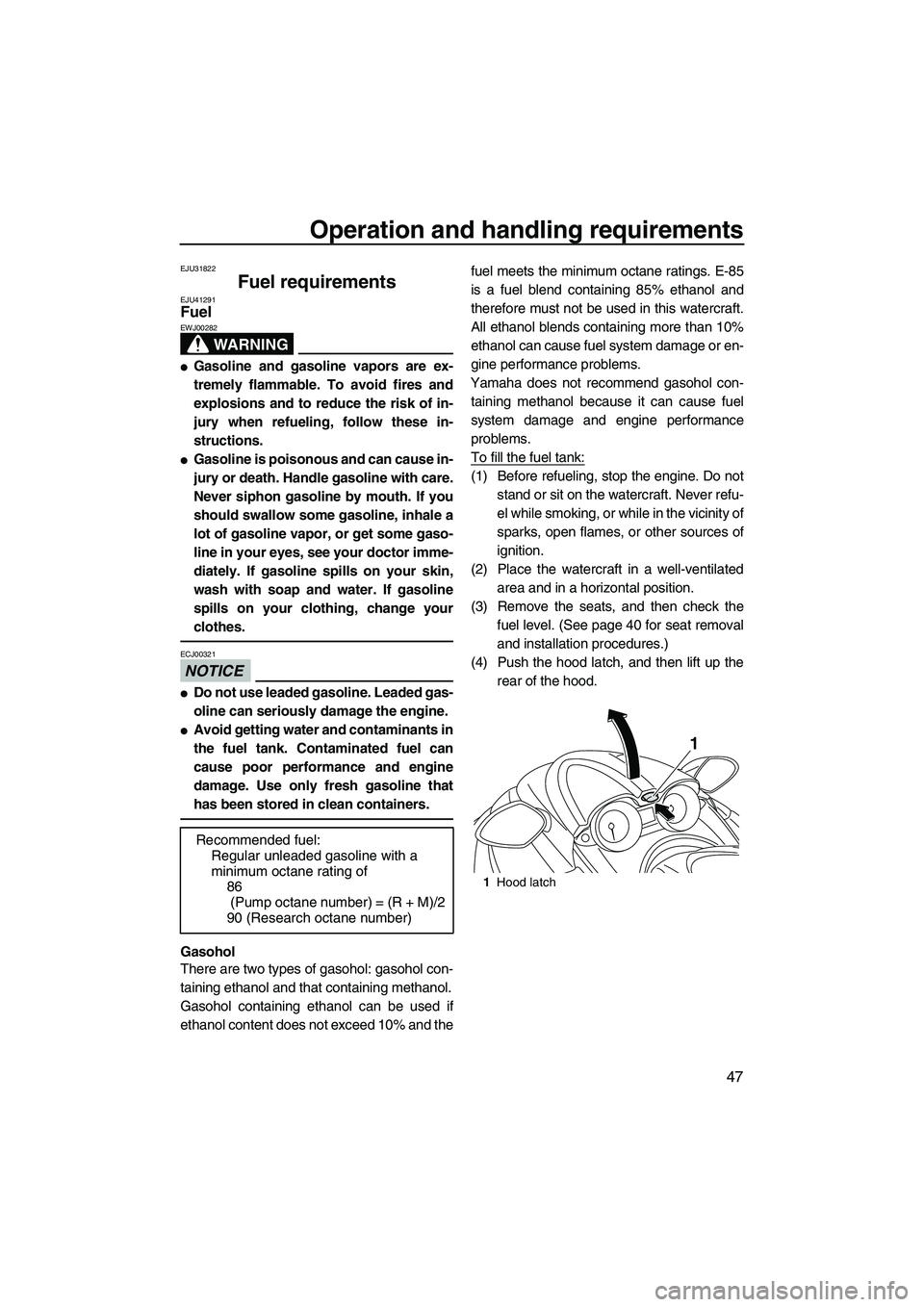
Operation and handling requirements
47
EJU31822
Fuel requirements EJU41291Fuel
WARNING
EWJ00282
●Gasoline and gasoline vapors are ex-
tremely flammable. To avoid fires and
explosions and to reduce the risk of in-
jury when refueling, follow these in-
structions.
●Gasoline is poisonous and can cause in-
jury or death. Handle gasoline with care.
Never siphon gasoline by mouth. If you
should swallow some gasoline, inhale a
lot of gasoline vapor, or get some gaso-
line in your eyes, see your doctor imme-
diately. If gasoline spills on your skin,
wash with soap and water. If gasoline
spills on your clothing, change your
clothes.
NOTICE
ECJ00321
●Do not use leaded gasoline. Leaded gas-
oline can seriously damage the engine.
●Avoid getting water and contaminants in
the fuel tank. Contaminated fuel can
cause poor performance and engine
damage. Use only fresh gasoline that
has been stored in clean containers.
Gasohol
There are two types of gasohol: gasohol con-
taining ethanol and that containing methanol.
Gasohol containing ethanol can be used if
ethanol content does not exceed 10% and thefuel meets the minimum octane ratings. E-85
is a fuel blend containing 85% ethanol and
therefore must not be used in this watercraft.
All ethanol blends containing more than 10%
ethanol can cause fuel system damage or en-
gine performance problems.
Yamaha does not recommend gasohol con- taining methanol because it can cause fuel
system damage and engine performance
problems.
To fill the fuel tank:
(1) Before refueling, stop the engine. Do not stand or sit on the watercraft. Never refu-
el while smoking, or while in the vicinity of
sparks, open flames, or other sources of
ignition.
(2) Place the watercraft in a well-ventilated area and in a horizontal position.
(3) Remove the seats, and then check the fuel level. (See page 40 for seat removal
and installation procedures.)
(4) Push the hood latch, and then lift up the rear of the hood.
Recommended fuel: Regular unleaded gasoline with a
minimum octane rating of86
(Pump octane number) = (R + M)/2
90 (Research octane number)
1Hood latch
1
UF2R74E0.book Page 47 Wednesday, August 22, 2012 2:26 PM
Page 82 of 104
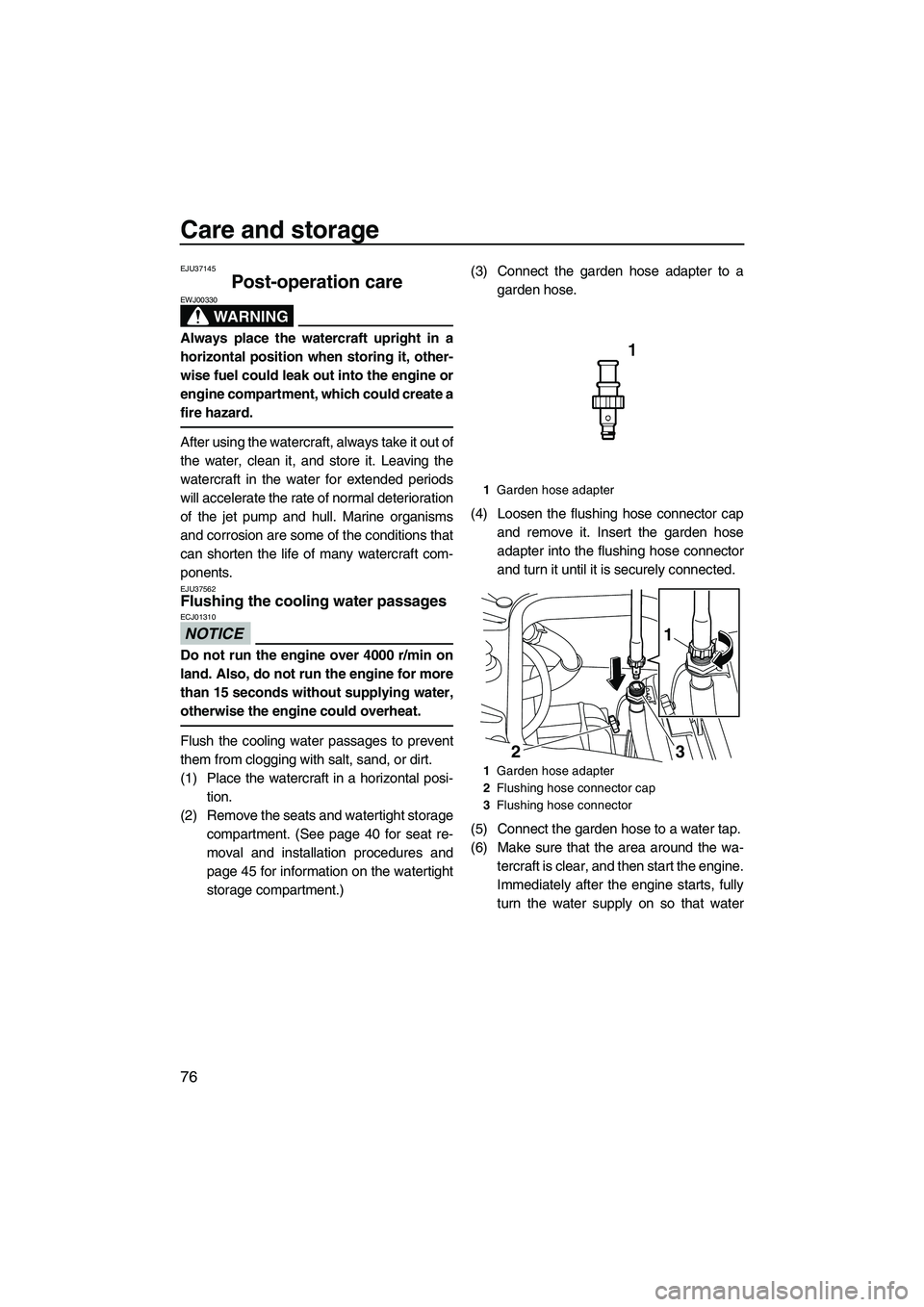
Care and storage
76
EJU37145
Post-operation care
WARNING
EWJ00330
Always place the watercraft upright in a
horizontal position when storing it, other-
wise fuel could leak out into the engine or
engine compartment, which could create a
fire hazard.
After using the watercraft, always take it out of
the water, clean it, and store it. Leaving the
watercraft in the water for extended periods
will accelerate the rate of normal deterioration
of the jet pump and hull. Marine organisms
and corrosion are some of the conditions that
can shorten the life of many watercraft com-
ponents.
EJU37562Flushing the cooling water passages
NOTICE
ECJ01310
Do not run the engine over 4000 r/min on
land. Also, do not run the engine for more
than 15 seconds without supplying water,
otherwise the engine could overheat.
Flush the cooling water passages to prevent
them from clogging with salt, sand, or dirt.
(1) Place the watercraft in a horizontal posi-tion.
(2) Remove the seats and watertight storage compartment. (See page 40 for seat re-
moval and installation procedures and
page 45 for information on the watertight
storage compartment.) (3) Connect the garden hose adapter to a
garden hose.
(4) Loosen the flushing hose connector cap and remove it. Insert the garden hose
adapter into the flushing hose connector
and turn it until it is securely connected.
(5) Connect the garden hose to a water tap.
(6) Make sure that the area around the wa- tercraft is clear, and then start the engine.
Immediately after the engine starts, fully
turn the water supply on so that water
1Garden hose adapter
1 Garden hose adapter
2 Flushing hose connector cap
3 Flushing hose connector
23 1
UF2R74E0.book Page 76 Wednesday, August 22, 2012 2:26 PM
Page 90 of 104

Maintenance
84
EJU37062Periodic maintenance chart
The periodic maintenance chart gives general guidelines for periodic maintenance. Have a
Yamaha dealer perform the checks in the following chart. However, maintenance may need to be performed more frequently depending on your operating conditions. If you have any ques-
tions, consult a Yamaha dealer.
This “ ” mark indicates items to be checked and serviced by a Yamaha dealer.
Item OperationInitial
Thereafter every
Page
10
hours 50 hours
100
hours 200
hours
6
months 12
months 12
months 24
months
Spark plugs Check, clean, replace —
Lubrication points Lubricate —
Internal engine
components Spray lubricant
—
Intermediate hous-
ing Lubricate
—
Fuel system Check —
Fuel tank Check, clean —
Engine idling
speed Check, adjust
—
Throttle shaft Check —
Water inlet strain-
er Check, clean
—
Bilge strainer Clean —
Electric bilge
pump strainer Clean
—
Impeller Check —
Jet thrust nozzle
angle Check, adjust
—
Steering master Check, adjust —
Q.S.T.S. mecha-
nism Check, adjust
—
Shift cable and re-
verse gate Check, adjust
—
Throttle cable Check —
Stern drain plugs Check, replace —
Battery Check, charge —
Rubber coupling Check —
UF2R74E0.book Page 84 Wednesday, August 22, 2012 2:26 PM
Page 92 of 104
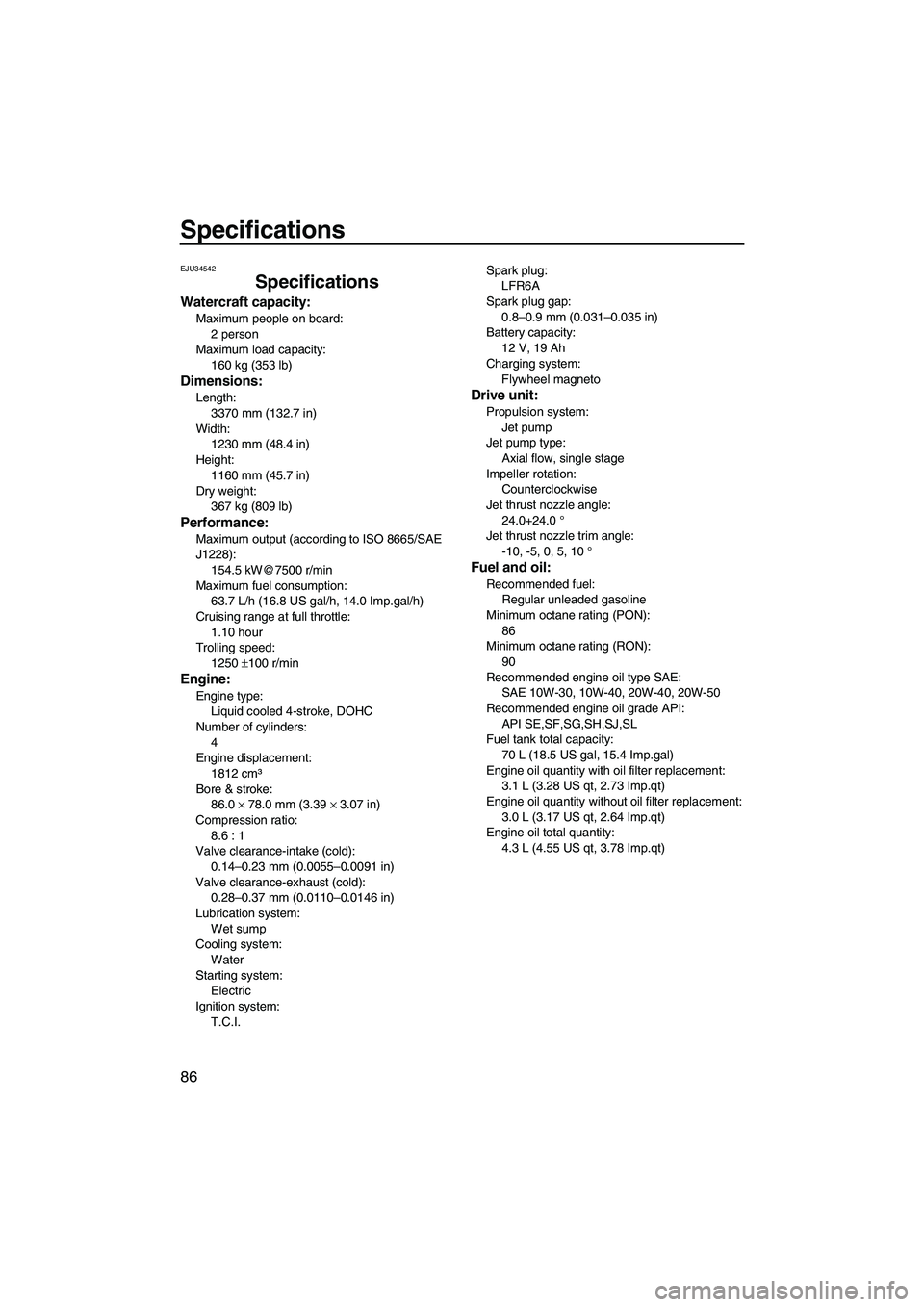
Specifications
86
EJU34542
Specifications
Watercraft capacity:
Maximum people on board:2 person
Maximum load capacity: 160 kg (353 lb)
Dimensions:
Length:
3370 mm (132.7 in)
Width: 1230 mm (48.4 in)
Height: 1160 mm (45.7 in)
Dry weight: 367 kg (809 lb)
Performance:
Maximum output (according to ISO 8665/SAE
J1228):
154.5 kW@7500 r/min
Maximum fuel consumption: 63.7 L/h (16.8 US gal/h, 14.0 Imp.gal/h)
Cruising range at full throttle: 1.10 hour
Trolling speed:
1250 ±100 r/min
Engine:
Engine type:
Liquid cooled 4-stroke, DOHC
Number of cylinders:
4
Engine displacement: 1812 cm³
Bore & stroke: 86.0 × 78.0 mm (3.39 × 3.07 in)
Compression ratio:
8.6 : 1
Valve clearance-intake (cold): 0.14–0.23 mm (0.0055–0.0091 in)
Valve clearance-exhaust (cold): 0.28–0.37 mm (0.0110–0.0146 in)
Lubrication system:
Wet sump
Cooling system: Water
Starting system: Electric
Ignition system:
T.C.I. Spark plug:
LFR6A
Spark plug gap: 0.8–0.9 mm (0.031–0.035 in)
Battery capacity:
12 V, 19 Ah
Charging system: Flywheel magneto
Drive unit:
Propulsion system:
Jet pump
Jet pump type: Axial flow, single stage
Impeller rotation: Counterclockwise
Jet thrust nozzle angle: 24.0+24.0 °
Jet thrust nozzle trim angle:
-10, -5, 0, 5, 10 °
Fuel and oil:
Recommended fuel:Regular unleaded gasoline
Minimum octane rating (PON):
86
Minimum octane rating (RON): 90
Recommended engine oil type SAE: SAE 10W-30, 10W-40, 20W-40, 20W-50
Recommended engine oil grade API:
API SE,SF,SG,SH,SJ,SL
Fuel tank total capacity: 70 L (18.5 US gal, 15.4 Imp.gal)
Engine oil quantity with oil filter replacement: 3.1 L (3.28 US qt, 2.73 Imp.qt)
Engine oil quantity without oil filter replacement:
3.0 L (3.17 US qt, 2.64 Imp.qt)
Engine oil total quantity: 4.3 L (4.55 US qt, 3.78 Imp.qt)
UF2R74E0.book Page 86 Wednesday, August 22, 2012 2:26 PM
Page 93 of 104
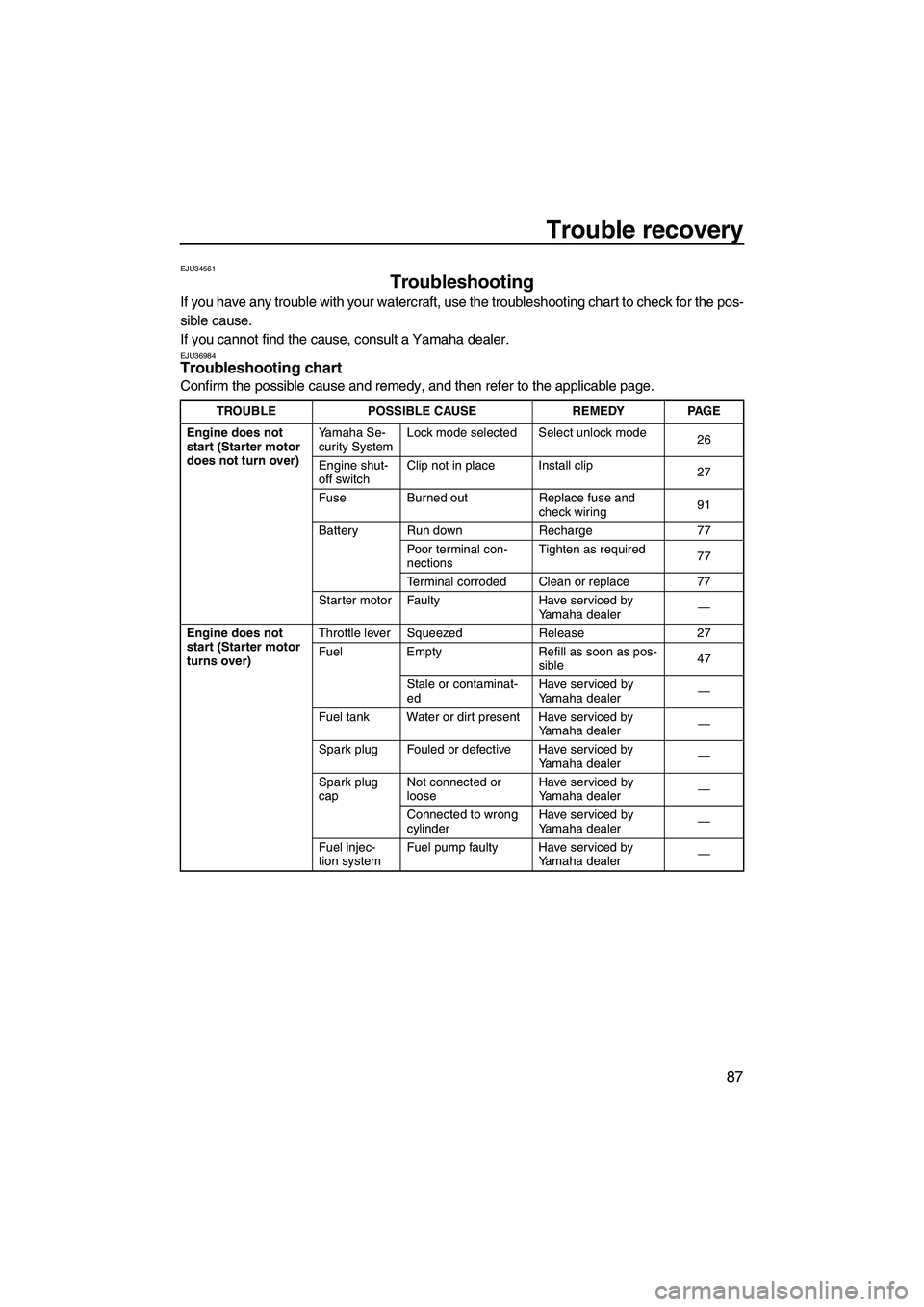
Trouble recovery
87
EJU34561
Troubleshooting
If you have any trouble with your watercraft, use the troubleshooting chart to check for the pos-
sible cause.
If you cannot find the cause, consult a Yamaha dealer.
EJU36984Troubleshooting chart
Confirm the possible cause and remedy, and then refer to the applicable page.
TROUBLE POSSIBLE CAUSE REMEDYPAGE
Engine does not
start (Starter motor
does not turn over) Yamaha Se-
curity System
Lock mode selected Select unlock mode
26
Engine shut-
off switch Clip not in place Install clip
27
Fuse Burned out Replace fuse and
check wiring 91
Battery Run down Recharge77
Poor terminal con-
nections Tighten as required
77
Terminal corroded Clean or replace 77
Starter motor Faulty Have serviced by
Yamaha dealer —
Engine does not
start (Starter motor
turns over) Throttle lever Squeezed
Release27
Fuel Empty Refill as soon as pos-
sible 47
Stale or contaminat-
ed Have serviced by
Yamaha dealer
—
Fuel tank Water or dirt present Have serviced by Yamaha dealer—
Spark plug Fouled or defective Have serviced by Yamaha dealer—
Spark plug
cap Not connected or
loose Have serviced by
Yamaha dealer
—
Connected to wrong
cylinder Have serviced by
Yamaha dealer
—
Fuel injec-
tion system Fuel pump faulty Have serviced by
Yamaha dealer —
UF2R74E0.book Page 87 Wednesday, August 22, 2012 2:26 PM
Page 102 of 104
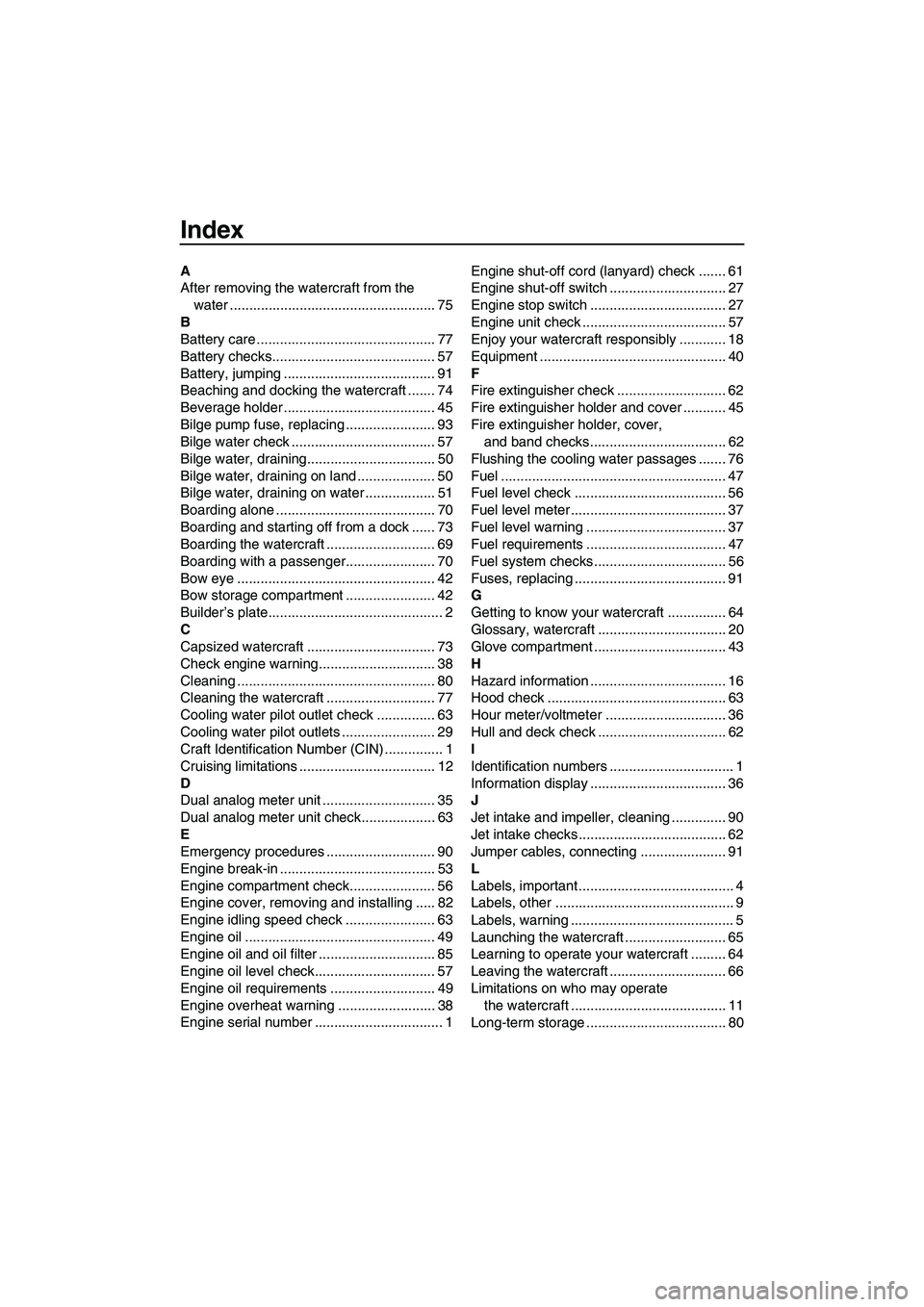
Index
A
After removing the watercraft from the water ..................................................... 75
B
Battery care .............................................. 77
Battery checks.......................................... 57
Battery, jumping ....................................... 91
Beaching and docking the watercraft ....... 74
Beverage holder ....................................... 45
Bilge pump fuse, replacing ....................... 93
Bilge water check ..................................... 57
Bilge water, draining................................. 50
Bilge water, draining on land .................... 50
Bilge water, draining on water .................. 51
Boarding alone ......................................... 70
Boarding and starting off from a dock ...... 73
Boarding the watercraft ............................ 69
Boarding with a passenger....................... 70
Bow eye ................................................... 42
Bow storage compartment ....................... 42
Builder’s plate............................................. 2
C
Capsized watercraft ................................. 73
Check engine warning.............................. 38
Cleaning ................................................... 80
Cleaning the watercraft ............................ 77
Cooling water pilot outlet check ............... 63
Cooling water pilot outlets ........................ 29
Craft Identification Number (CIN) ............... 1
Cruising limitations ................................... 12
D
Dual analog meter unit ............................. 35
Dual analog meter unit check................... 63
E
Emergency procedures ............................ 90
Engine break-in ........................................ 53
Engine compartment check...................... 56
Engine cover, removing and installing ..... 82
Engine idling speed check ....................... 63
Engine oil ................................................. 49
Engine oil and oil filter .............................. 85
Engine oil level check............................... 57
Engine oil requirements ........................... 49
Engine overheat warning ......................... 38
Engine serial number ................................. 1 Engine shut-off cord (lanyard) check ....... 61
Engine shut-off switch .............................. 27
Engine stop switch ................................... 27
Engine unit check ..................................... 57
Enjoy your watercraft responsibly ............ 18
Equipment ................................................ 40
F
Fire extinguisher check ............................ 62
Fire extinguisher holder and cover ........... 45
Fire extinguisher holder, cover,
and band checks................................... 62
Flushing the cooling water passages ....... 76
Fuel .......................................................... 47
Fuel level check ....................................... 56
Fuel level meter ........................................ 37
Fuel level warning .................................... 37
Fuel requirements .................................... 47
Fuel system checks .................................. 56
Fuses, replacing ....................................... 91
G
Getting to know your watercraft ............... 64
Glossary, watercraft ................................. 20
Glove compartment .................................. 43
H
Hazard information ................................... 16
Hood check .............................................. 63
Hour meter/voltmeter ............................... 36
Hull and deck check ................................. 62
I
Identification numbers ................................ 1
Information display ................................... 36
J
Jet intake and impeller, cleaning .............. 90
Jet intake checks ...................................... 62
Jumper cables, connecting ...................... 91
L
Labels, important ........................................ 4
Labels, other .............................................. 9
Labels, warning .......................................... 5
Launching the watercraft .......................... 65
Learning to operate your watercraft ......... 64
Leaving the watercraft .............................. 66
Limitations on who may operate the watercraft ........................................ 11
Long-term storage .................................... 80
UF2R74E0.book Page 1 Wednesday, August 22, 2012 2:26 PM